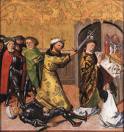
[This is taken from Augustine Calmet's Phantom World, originally published in 1850, revised and edited by D. J. McAdam, 2010. Copyright as such.]

All the lives of the saints are full of resurrections of the dead; thick volumes might be composed on the subject.
These resurrections have a manifest relation to the matter which we are here treating of, since it relates to persons who are dead, or held to be so, who appear bodily and animated to the living, and who live after their return to life. I shall content myself with relating the history of St. Stanislaus, Bishop of Cracow, who restored to life a man that had been dead for three years, attended by such singular circumstances, and in so public a manner, that the thing is beyond the severest criticism. If it is really true, it must be regarded as one of the most unheard of miracles which are read of in history. They assert that the life of this saint was written either at the time of martyrdom, or a short time afterwards, by different well-informed authors; for the martyrdom of the saint, and, above all, the restoration to life of the dead man of whom we are about to speak, were seen and known by an infinite number of persons, by all the court of King Boleslaus. And this event having taken place in Poland, where vampires are frequently met with even in our days, it concerns, for that reason, more particularly the subject we are treating.
The bishop, St. Stanislaus, having bought of a gentleman, named Pierre, an estate situated on the banks of the Vistula, in the territory of Lublin, for the profit of his church at Cracow, gave the price of it to the seller, in the presence of witnesses, and with the solemnities requisite in that country, but without written deeds, for they then wrote but seldom in Poland on the occasion of sales of this kind; they contented themselves with having witnesses. Stanislaus took possession of this estate by the king's authority, and his church enjoyed it peaceably for about three years.
In the interim, Pierre, who had sold it, happened to die. The king of Poland, Boleslaus, who had conceived an implacable hatred against the holy bishop, because he had freely reproved him for his excesses, seeking occasion to cause him trouble, excited against him the three sons of Pierre, and his heirs, and told them to claim the estate which their father had sold, on pretence of its not having been paid for. He promised to support their demand, and to cause it to be restored to them. Thus these three gentlemen had the bishop cited to appear before the king, who was then at Solech, occupied in rendering justice under some tents in the country, according to the ancient custom of the land, in the general assembly of the nation. The bishop was cited before the king, and maintained that he had bought and paid for the estate in question. The day was beginning to close, and the bishop ran great risk of being condemned by the king and his counselors. Suddenly, as if inspired by the Divine Spirit, he promised the king to bring him in three days Pierre, of whom he had bought it, and the condition was accepted mockingly, as a thing impossible to be executed.
The holy bishop repairs to Pictravin, remains in prayer, and keeps fast with his household for three days; on the third day he goes in his pontifical robes, accompanied by his clergy and a multitude of people, causes the grave-stone to be raised, and makes them dig until they found the corpse of the defunct all fleshless and corrupted. The saint commands him to come forth and bear witness to the truth before the king's tribunal. He rises; they cover him with a cloak; the saint takes him by the hand, and leads him alive to the feet of the king. No one had the boldness to interrogate him; but he took the word, and declared that he had in good faith sold the estate to the prelate, and that he had received the value of it; after which he severely reprimanded his sons, who had so maliciously accused the holy bishop.
Stanislaus asked Pierre if he wished to remain alive to do penance. He thanked him, and said he would not anew expose himself to the danger of sinning. Stanislaus accompanied him to his tomb, and being arrived there, he again fell asleep in the Lord. It may be supposed that such a scene had an infinite number of witnesses, and that all Poland was quickly informed of it. The king was only the more irritated against the saint. He some time after killed him with his own hand, as he was coming from the altar, and had his body cut into seventy-two parts, in order that they might never more be collected together in order to pay them the worship which was due to them as the body of a martyr for the truth and for pastoral liberty.
Now then let us come to that which is the principal subject of these researches, the vampires, or revenans, of Hungary, Moravia, and similar ones, which appear only for a little time in their natural bodies.
© D J McAdam. Please note: all applicable material on this website is protected by law and may not be copied without express written permission.
Home | Book Collecting | Folklore / Myth | Philately | Playing Cards | Literature | Contents